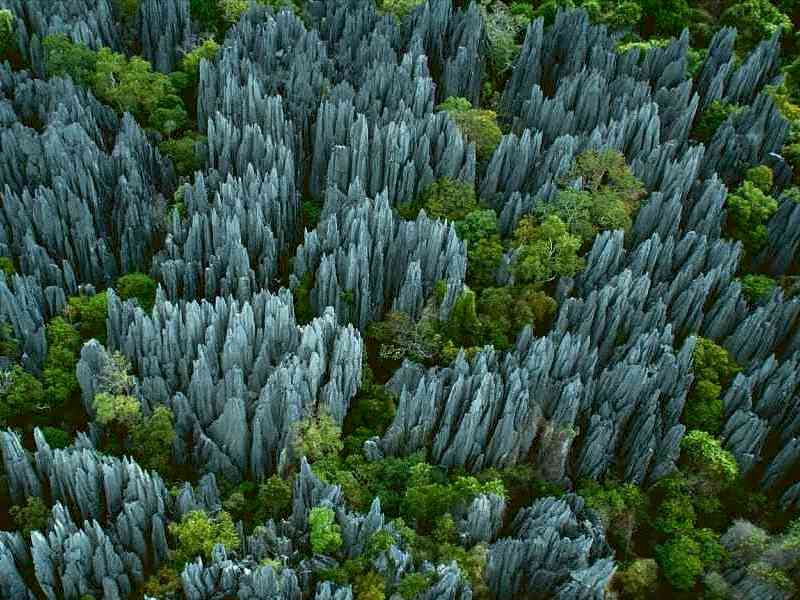Gracefully Dissolving
Madagascan KarstOf all the wonders of nature, a tree in summer is perhaps the most remarkable; - Woody Allen
Tsingy of Bemaraha, Morondava region, Madagascar (18°47' S, 45°03' E) The strange mineral forest of Tsingy of Bemaraha stands on the western coast of Madagascar. This geological formation, called a karst, is the result of erosion, as acid rains have gradually dissolved the stone of the chalky plateau and carved out sharp ridges that can rise to heights of 95 feet (30 m). This nearly impenetrable labyrinth (tsingy is the Malagasy term for "walking on tiptoe") shelters its own unique flora and fauna, which have not been completely recorded. The site was declared a nature reserve in 1927 and a UNESCO World Heritage site in 1990. Madagascar is a 230,000-square-mile (587,000 km2) fragment of earth produced by continental drift, isolated for 100 million years in the Indian Ocean off the coast of southern Africa, and has thus developed distinctive and diverse animal and plant species, sometimes with archaic characteristics. It has an exceptional rate of endemism: more than 80% of the approximately 12,000 plant species and nearly 1,200 animal species recorded are indigenous to the island only; but close to 200 Madagascan species are in danger of extinction. Source: yannarthusbertrand.com from Earth from Above by the incomparable photographer Yann Arthus-Bertrand. Visit his site to see lovely photos of all sorts of things. For more about karst, see also:
For more about Madagascar, see also:
For more articles relating to Money, Politics and Law including globalisation, tax avoidance, consumerism, credit cards, spending, contracts, trust, stocks, fraud, eugenics and more
click the "Up" button below to take you to the page on "How Many Countries in the World?" Clicking "Up" from there will take you to the Index for this section. |
 Animals
Animals Animation
Animation Art of Playing Cards
Art of Playing Cards Drugs
Drugs Education
Education Environment
Environment Flying
Flying History
History Humour
Humour Immigration
Immigration Info/Tech
Info/Tech Intellectual/Entertaining
Intellectual/Entertaining Lifestyles
Lifestyles Men
Men Money/Politics/Law
Money/Politics/Law New Jersey
New Jersey Odds and Oddities
Odds and Oddities Older & Under
Older & Under Photography
Photography Prisons
Prisons Relationships
Relationships Science
Science Social/Cultural
Social/Cultural Terrorism
Terrorism Wellington
Wellington Working
Working Zero Return Investment
Zero Return Investment